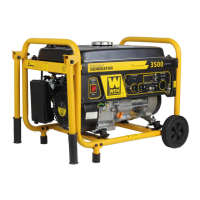15
USING THE GENERATOR
WARNING: When this generator is used on a building’s wiring system, the generator must be installed by a qual-
ified electrician and connected to a transfer switch as a separately derived system in accordance with the National
Electrical Code, NFPA 70. The generator shall be connected to a transfer switch that switches all conductors
other than the equipment grounding conductor. The frame of the generator shall be connected to an approved
grounding electrode.
For power outages, permanently installed, stationary generators are better suited for providing backup power to
the home. Even a properly connected portable generator can become overloaded. This may result in overheat-
ing or stressing the machine’s components, possibly leading to a generator failure.
Before connecting electrical devices, allow the generator to run for a few minutes to stabilize the speed and voltage
output.
CAUTION: Become familiar with the markings on the panel before connecting electrical devices.
Connect electrical devices running on AC current according to their wattage requirements. The chart in Fig. 6
shows the rated and surge wattage of the generator.
The rated (running) wattage is the wattage the generator can produce on a continuous basis.
The surge wattage is the maximum amount of power the generator can produce for an extremely short period of
time (seconds). Many electrical devices such as refrigerators require short bursts of extra power in addition to the
rated wattage listed by the device to start their motors. The surge wattage ability of the generator covers this extra
power requirement.
Item Rated (Running) Wattage Surge Wattage
56352 3000 3500
Fig. 6 - Generator Wattage
The total running wattage requirement of the electrical devices connected to the generator should not exceed the
rated wattage of the generator itself. To calculate the total wattage requirement of the electrical devices you plan
to connect, find the rated (or running) wattage of each device. This number should be listed somewhere on the
device or in its instruction manual. If this wattage cannot be found, calculate it by multiplying the Voltage require-
ment by the Amperage drawn: Watts = Volts x Amperes
Estimated wattages are available in Fig. 7. Do not solely rely on this chart - all electronics and appliances are built
differently. These are not standard wattages across the board, only estimations.
When the rated wattage requirement of each electrical device has been determined, add these numbers to find
the total rated wattage needed. If this number exceeds the rated wattage of the generator, DO NOT connect all
these devices. Select a combination of electrical devices, which have a total rated wattage lower than or equal to
the rated wattage of the generator.
CIRCUIT RESET BUTTONS help to prevent electrical overload. If your receptacle short circuits or becomes
overloaded by an electrical device or devices with too great a wattage rating, the circuit protector may shut off
power to the receptacle. If this happens, you will see the voltage indicator lights turn off and you will not be able
to draw power from the overloaded receptacle. In the event of such an overload, disconnect all electrical devices
from the generator and press the circuit reset buttons. If power still does not return to the receptacle, call our cus-
tomer help line at 1-800-232-1195.

